Grassroots Tactics and the Appropriation of State Nationalist Rhetoric: Protest, Mockery, and Performance in Hong Kong
Background on Hong Kong’s Anti-Chinese Tourism Protests
As a semi-autonomous Special Administrative Region, Hong Kong has been granted a high degree of political freedom and economic independence from Beijing. However, as the Chinese government tightens its grip on the city legally, politically and economically, the people of Hong Kong become increasingly anxious about maintaining a separate identity and political outlook that challenge the state’s demand for national unity (Guo). However, their actions are complicated by the fact that Hong Kong’s economy now relies heavily on China, both in terms of trade and tourism.
In 2003, the Chinese government implemented the Individual Travel Scheme that would allow mainland tourists to visit Hong Kong more freely than before. While this project was promoted by both the Chinese and Hong Kong governments as beneficial to the city’s economy, it is also interpreted by the people of Hong Kong as China’s political attempt to further rein in this Special Administrative Region to reinforce a sense of national unity (Ong 103). In just 2013 alone, the number of mainland tourists who have visited Hong Kong reached an all-time high of 4,000,000. The large presence of mainland Chinese tourists has triggered among the people of Hong Kong an identity crisis and anxiety over their political future. As a result, many Hong Kong people have labeled mainland tourists “locusts,” arguing that they have illegitimately occupied the public space and infrastructure of the city.
In February and March of 2014, an anti-China grassroots organization called The Voice of Loving Hong Kong used social media as a platform to organize a series of protests against mainland tourists, which they vividly titled the “Locust Expulsion Movement.” Because of the suppression launched by the Chinese and Hong Kong government after the first protest, the group of protesters have then turned to rely on non-traditional forms of resistance—such as mockery, creative uses of their bodies and space, and the appropriation of Chinese state nationalist discourse—to further their claims.
Echoing recent rhetoric scholarship that studies the tactical performances and hybrid rhetoric deployed by grassroots communities (see Cisneros; Enzk-Wanzer; McDougal; Nordstrom), I demonstrate through this case study that in the face of state suppression and power imbalance, grassroots communities can draw on contradictions, make use of their bodies and other available resources, and turn dominant discourses on their head to advance unsanctioned arguments and to assert their own difference in political identity. This case study, in particular, illustrates how grassroots tactics are not only useful in making room for alternative narratives and identities in a hostile environment—they can also be so creative and politically powerful that they implicate state authority and thus compromise the state’s ability to suppress unpopular discourses.
Method and Artifacts
Driven by Michel de Certeau’s concept of tactics, I seek to examine how the grassroots community in Hong Kong creatively mobilizes space and different material resources—including members’ bodies—to circumvent state suppression while challenging dominant nationalist discourses. Defined as “an art of the weak” (de Certeau 37), tactics are used by unsanctioned groups to take advantage of whatever is available to them. Because these communities must operate on a space controlled by the dominant power, they must “vigilantly make use of the cracks that particular conjunctions open in the surveillance of the proprietary powers” (de Certeau 37). When groups are not allowed access to participate on the dominant platform, they “make do” by refashioning the space using everyday materials that are available to them (Enzk-Wanzer 346).
Given such definitions of tactics, I analyze news reporting, videos, and photos of the second protest in the Locust Expulsion Movement, paying particular attention to the protesters’ creative usage of public space and the deployment of seemingly mundane objects to perform unsanctioned arguments. The second protest is particularly significant here because it was orchestrated as a creative response to the state’s scathing condemnation and suppression of the first event. While the activists later organized a third protest, its format was largely the same and did not attract as much media attention as the second performance.
In addition to embodied performances in public space, I am also interested in examining the appropriation of dominant state discourses as a tactic for grassroots communities to temporarily manipulate their hostile political and cultural surroundings. Defined by Kent Ono and John Sloop as “logics of judgment” that are supported by institutions (14), dominant discourses appear at first glance to only be available to those who are in power. However, as discourses travel, they become open for appropriation and are no longer within the sole control of the institution or the state (Hesford 11). Therefore, I pay special attention to the way grassroots activists co-opted, transformed, and redeployed dominant state nationalist rhetoric.
Extending the line of inquiry on tactical and hybrid political practices by grassroots communities (See Cisneros; Enzk-Wanzer; Yang), I will demonstrate through my case study that because they must “make do,” grassroots communities often deploy tactics to respond to institutional pressure creatively; while these tactics can undermine the authority of the state by re-purposing its dominant rhetoric, they also rely on unexpected use of bodies and space to make marginalized claims visible in public. Given the right context and materials, tactics can be used not only to make space for marginalized discourses—they can even function as a tool for resistance to confuse state authorities, deter suppression, and destabilize dominant state logics.
The Use of Mockery and State Nationalist Rhetoric as Grassroots Resistance
As an effort to express their anger over the overwhelming presence of mainland tourists, in late February of 2014 two hundred local Hong Kong citizens enacted the first installment of the “Locust Expulsion Movement,” in which protesters arrived at tourist spots to confront those they saw as invaders of the city. Unlike most anti-China protests that had occurred before, this one quickly escalated as angry participants were on the verge of physically attacking the tourists. After the protest ended, key officials from both the Hong Kong and Chinese governments publicly denounced the actions of the organizers and participants, claiming that their actions “mirror Fascism” (“Some Near-Fascist Hong Kongers”). Because the Hong Kong government was backed by Beijing and was therefore anxious to maintain a good relationship with China, it—in addition to sending in a disproportionately large police force during the protest—issued public statements to warn protesters that the government would not hesitate to legally prosecute anyone who threatened Hong Kong’s tourism industry and would “definitely not allow similar events to occur” (“Official Media Repeatedly Denounce”; “The Government Exaggerating Their Attacks”).
In order to avoid government suppression, the protest organizers decided to tactically and humorously enact the second installment: instead of an organized protest with direct confrontations, local participants would mimic mainland tourists by dragging their suitcases around tourist hotspots and mocking the mainland tourists they encountered on the way. Mimicking the accent of mainland tourists, some protesters loudly repeated the logic that some mainland Chinese subscribed to: “Without China’s support, Hong Kong would be over a long time ago;” yet other protesters decided to mock what they saw as the tourists’ “uncivilized” behavior by dashing in and out of the crowd with their suitcases (“Netizens Protest”). Instead of asserting their difference, local protesters temporarily embodied mainland tourists as a way to mock their behaviors and implied the illegitimacy of their presence in Hong Kong (see Fig. 1).
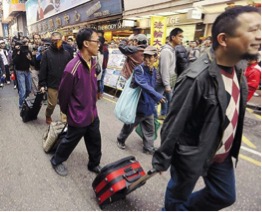
These tactics have given the protesters leverage against the government. Because their walks were arranged informally online with no clear organizers, participants did not need to seek permission from the Police Department ahead of time. In addition to bypassing institutional control, such tactical use of public space and embodied performances allowed the protesters to confuse the authorities. Because the protesters were mimicking the behavior of the tourists, police officers on site were sometimes unable to distinguish between the two groups. According to one observer, during the participants’ informal “leisure walk,” the Hong Kong police made the mistake of confronting a group of mainland tourists, thinking that they were part of the Locust Expulsion Movement (“Locust Expulsion Changing Shapes”). The image (Fig. 2) below shows actual Chinese tourists in Hong Kong—the resemblance between them and the Hong Kong protesters is quite apparent:
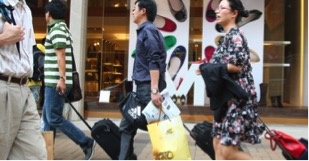
In addition, as Guobin Yang, argues, “by calling on citizens to take a ‘leisure walk’ rather than join a premeditated demonstration, the organizers added a lighthearted tone to a serious event … It was also an effective rhetorical strategy to forestall potential government repression, because even harsh government authorities would find it hard not to let citizens take ‘leisure walks’” (74).1 In other words, by injecting a sense of play and informality into an otherwise serious confrontation, the protesters were able to evade the suppression of state authorities.
Because the movement participants were using the public space the same way that the tourists did, the Hong Kong government was also unable to prosecute them with public obstruction without implicating the tourists themselves. The Movement’s original goal was to overcome state suppression and reclaim the city’s public space from the encroachment of Chinese influence; by enacting what de Certeau would call “trickery” (37), local protesters are able to circumvent official control while putting the Hong Kong government in a double bind. On the one hand, the Hong Kong government must suppress subversive anti-China movements; on the other hand, the protesters’ tactics had made it almost impossible for the government to only target them without also harming the interests of mainland tourists.
After the initial success with their new tactics, the Movement’s participants decided to further rely on embodied performances and the appropriation of dominant discourses. This time, protesters had chosen to draw on and re-purpose nationalist discourse that has traditionally been deployed by the Chinese state government for nation-building. Titled “Love the Nation, Love the Communist Party,” the third protest sought to “educate” mainland tourists about the importance of purchasing and using Chinese-made products, instead of shopping for imported goods in Hong Kong. Using social media as their platform, the organizers had come up with satirical slogans that borrow from Chinese nationalist rhetoric: “Don’t be fooled by Western capitalism; shop within your own country,” “If you purchase foreign products, you are helping Western imperialism destroy China,” and “Don’t consume in Hong Kong; once Hong Kong becomes rich, it will try to become independent!” On March 9, donning costumes from the Cultural Revolution and holding copies of Ma Zedong’s Little Red Book, over a hundred protesters held up banners of these nationalist slogans and marched across the popular tourist spots (see Figs. 3, 4, and 5). As shown in these images and the following video, this protest was not only highly performative, but it was also conducted in a light-hearted and almost festive manner: as they embodied and mocked archetypal communist figures and ideologies, these Hong Kong protesters could barely stop grinning.

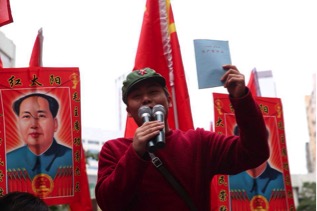
Fig. 5: Video taken during the performance, where a protester attempted to keep a straight face while “educating” mainland tourists how they could better show their love to the Chinese state.
These nationalist slogans with a socialist flair are politically powerful because they follow the nationalist logic constructed, circulated, and sanctioned by Beijing through platforms such as state-sponsored media, education, and rituals (Guo; Lu and Simons). As Yingjie Guo points out, “As the Chinese Communist Party (CCP)’s legitimization relies heavily on a Marxist narrative of Chinese history and historical destiny, any challenge to this narrative is a challenge to the CCP’s legitimacy” (2). In other words, even though the Chinese state no longer practices socialism, the CCP continues to deploy Marxist narratives to preserve its political status and to construct a coherent nation that adheres to the logics of the Party. Since the Hong Kong protesters are now overtly performing these slogans as if they agree with their underlying ideology, the Chinese state cannot suppress the protesters without implying their own logics are at fault.
Co-opting these state-sponsored rhetorics and logics, therefore, allows Hong Kong protesters to mount three political claims at the same time: to reveal the capitalist tendencies of mainland Chinese who have received state-sponsored Socialist education, to mock the contradictions between the Party’s communist rhetoric and its capitalist economic policies, and finally, to signal Hong Kong people’s irreverence towards Beijing’s nationalist logic. Touting sanctioned discourses as their slogans, protesters put the Hong Kong government in a difficult position because while the government knows full well the anti-Chinese intentions of the participants, they cannot overtly disagree with their campaign slogans without implicating Beijing’s nationalist logics. In addition, these slogans also put the mainland tourists in a similar bind: by heeding the protesters’ request, they would be giving in to their anti-China campaign, but they also could not disagree with the slogans without openly disagreeing with the Chinese state.
Satire by way of appropriation functions as a tactic here because “of the play that it introduces into the foundation of power” (de Certeau 39); as a result, it limits the actions state power can take without undermining its own ideology. This rhetorical form allows grassroots protesters to avoid prosecution because their subversive intentions are masked by their creative and humorous use of dominant state logics. The double meanings of satire give leeway for the protesters to dispute any accusations from the state as they can easily claim that the state has misinterpreted their intentions and actions, that the slogans should indeed be understood with their literal meanings. Even though the number of protesters who participated in this event was comparable to the first demonstration, neither the Chinese nor Hong Kong governments made harsh or threatening criticisms about their “nationalist campaigns.”
Conclusion
While recent scholarship has demonstrated the use of grassroots tactics and performances to challenge dominant logics and assert difference, my case study has shown that these tactics can be so powerful that they temporarily take away the state’s ability to suppress them while keeping their ideological foundation intact. By drawing on the genre of satire, protesters can evade state prosecution through the genre’s inherent ambiguity. Their creative use of embodied performances, on the other hand, allows them to destabilize categories the government uses to distinguish troublemakers from those it ought to protect. As a result, the state’s ability to respond and suppress is severely limited.
As grassroots movements become more adaptive against state suppression, we as rhetoricians must pay close attention not only to conventional forms of overt social movements, but also to creative, seemingly mundane, and facetious modes of resistance. While the elusiveness of these tactics allows grassroots communities to temporarily evade state control, we must also be attuned to their limitations. Since tactics are by nature temporary, spontaneous, and hinge upon an opportune time (de Certeau 39), they do not undermine state power in a substantial and material way. As grassroots communities engage in rhetorical guerrilla warfare, state authorities may as a response adapt and deploy the immense political and material resources they have. Such tension between grassroots tactics and state strategies demands further research because it poses questions not only about the efficacy of hybridized social movements, but also about the way state power responds to and interacts with alternative modes of resistance.
Endnotes
- While Yang’s observation is based on his study of grassroots activists in mainland China—who face even more drastic means of suppression—it nonetheless mirrors the way Hong Kong activists organized and protect themselves politically. return
Works Cited
- Cisneros, Josue David. “(Re)Bordering the Civic Imaginary: Rhetoric, Hybridity, and Citizenship in La Gran Marcha.” Quarterly Journal of Speech 97.1 (2011): 26–49. Print.
- De Certeau, Michel. The Practice of Everyday Life. Berkeley: U of California P, 2011. Print.
- Enck-Wanzer, Darrel. “Tropicalizing East Harlem: Rhetorical Agency, Cultural Citizenship, and Nuyorican Cultural Production.” Communication Theory 21.4 (2011): 344–367. Print.
- Guo, Yingjie. Cultural Nationalism in Contemporary China: The Search for National Identity under Reform. London: Routledge/Curzon, 2003. Print.
- Hesford, Wendy. Spectacular Rhetorics: Human Rights Visions, Recognitions, Feminisms. Durham, N.C.: Duke UP, 2011. Print.
- “Locust Expulsion Changing Shapes: Walking around Mong Kok with Suitcases.” Post 852. 23 Feb. 2014. Web. 1 Mar. 2014.
- Lu, Xing, and Herbert Simons. “Transitional Rhetoric of Chinese Communist Party Leaders in the Post-Mao Reform Period: Dilemmas and Strategies.” Quarterly Journal of Speech 92.3 (2006): 262–286. Print.
- McDougal, Brandy Nālani, and Georganne Nordstrom. “Ma Ka Hana ka ‘Ike (In the Work Is the Knowledge): Koana as Rhetorical Action.” College Composition and Communication 63.1 (2011): 98-121. Print.
- “Netizens Protest against Mainland Tourists with Their Suitcases.” Apple Daily. 23 Feb. 2014. Web. 1 Mar. 2014.
- “Official Media Repeatedly Denounce the Locust Expulsion Movement.” Oriental Daily. n.d. Web. 1 Mar. 2014.
- Ong, Aihwa. Neoliberalism as Exception: Mutations in Citizenship and Sovereignty. 1st ed. Durham, N.C.: Duke UP, 2006. Print.
- Ono, Kent A., and John Sloop. Shifting Borders: Rhetoric, Immigration, and California’s Proposition 187. Philadelphia: Temple UP, 2002. Print.
- Ray, Angela. “The Rhetorical Ritual of Citizenship: Women’s Voting as Public Performance, 1868-1875.” The Quarterly Journal of Speech 93.1 (2007): 1-26. Print.
- “Some Near-Fascist Hong Kongers Insult the Mainland: Who Is Cheering Them On.” Huanqiu. 18 Feb. 2014. Web. 1 Mar. 2014.
- Terrill, Robert. Malcolm X: Inventing Radical Judgment. East Lansing: Michigan State UP, 2007. Print.
- “The Government Exaggerating Their Attacks on the Locust Expulsion Movement.” Post 852. 18 Feb. 2014. Web. 1 Mar. 2014.
- Yang, Guobin. The Power of the Internet in China: Citizen Activism Online. New York: Columbia UP, 2009. Print.

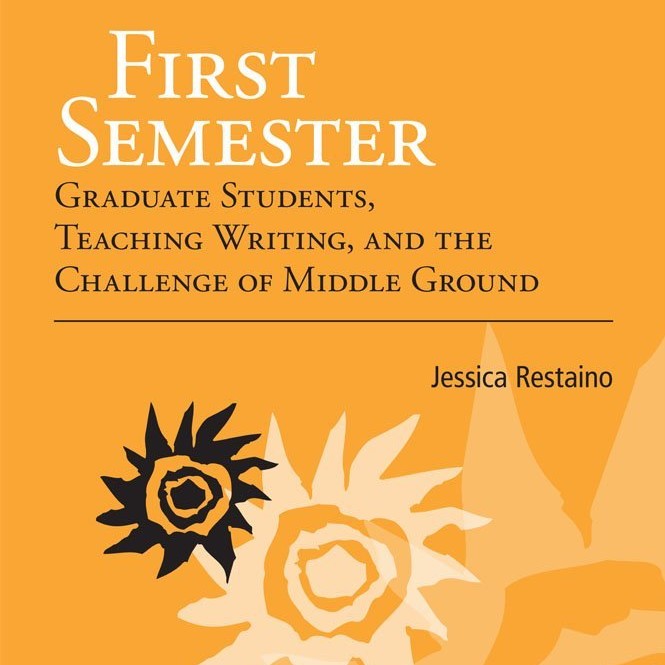
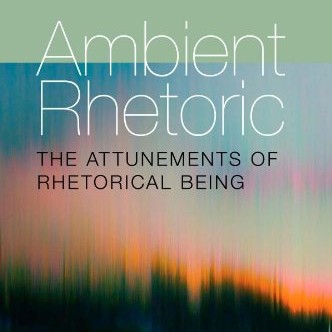
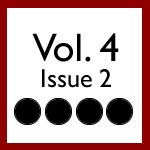
 Shui-yin Sharon Yam is a PhD candidate in Composition and Rhetoric at the University of Wisconsin-Madison. Her dissertation examines the intersection across affect, emotion, and transnational citizenship. Her article on nationalism and Hong Kong's Moral and National Education is forthcoming in the Howard Journal of Communications.
Shui-yin Sharon Yam is a PhD candidate in Composition and Rhetoric at the University of Wisconsin-Madison. Her dissertation examines the intersection across affect, emotion, and transnational citizenship. Her article on nationalism and Hong Kong's Moral and National Education is forthcoming in the Howard Journal of Communications.